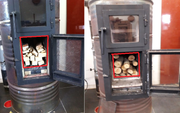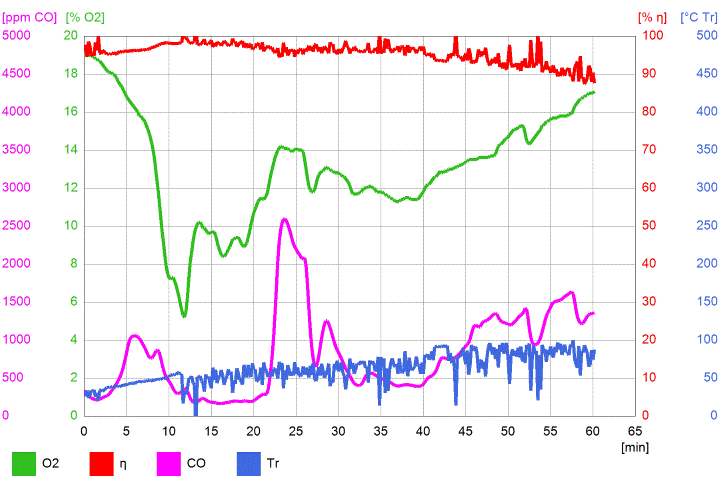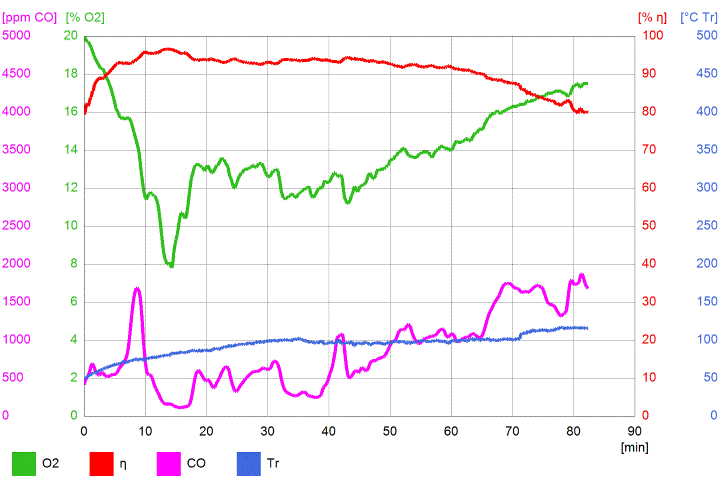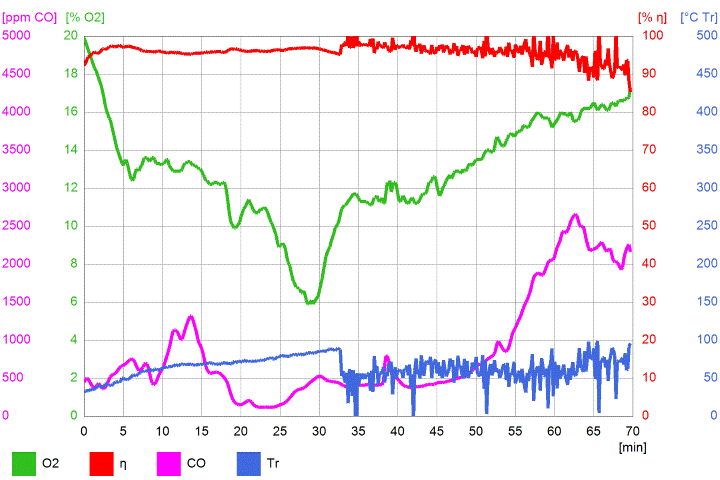|
|
Post by peterberg on Oct 28, 2020 7:59:15 GMT -8
Assuming Peters version has ceramic board (?) where Trevor’s has a steel plate for the roof .... do you see this difference having any significant effect? The ceiling of the top box is of ceramic board. yes. Although the shelf, being directly on top of the spinning flames is a cast refractory slab of 25 mm (1") thick. Hard to say what the difference would be. It seems that I am moving in the direction to build this core entirely out of (thin) firebricks and such so it would be easier for most people to build it. Also, it doesn't seem to be realistic to rule out the possibility of ceramic fibres in the exhaust stream. I wouldn't be surprised if they were. Core design isn't far from ready as yet as is the airframe door assembly. When it is I want to rebuild the whole thing out of firebrick slabs of just 30 mm (1.18"). Held together by a steel frame, an outer skeleton so to speak. Simply in order to investigate whether it would work along the same lines or not. When it is capable to function irrespectively of the materials it is built of, it would be truly a process that's relying on physics. Found a way to implement secondary air into the port, by the way. The ceiling of the firebox could be made out of two thin slabs, say, 5 mm apart. On the front side it could recieve its air from the air frame, the feed possibility is already there. This is just an idea, I need to work this out further. I would like to have the feed larger than the actual slit in the sides of the port for example. |
|
|
|
Post by Orange on Oct 28, 2020 8:54:49 GMT -8
if I got it right, primary air is comming from the opening on the bottom and secondary air trough the slits in the firebox frame on top/sides. I don't get why is this threshold so tall compared to DSR2? |
|
|
|
Post by Vortex on Oct 28, 2020 10:18:30 GMT -8
martyn A metal or ceramic cooktop shouldn't have any effect on the combustion at that point as it should be over, if not then it's overfuelling in which case it isn't working right. Peter, Why not use insulating firebrick? They don't contain ceramic fibers and seem to last as long as normal firebricks if they're not knocked about. Occasionally they crack but don't seem to degrade further if left in the same position. Lots of stoves are using vermiculite firebrick these days. I'm starting to think my initial experience with vermiculite board cracking was due to it being outside where it was getting damp or wet between firings. All the pieces I have used since in my afterburner indoors have stayed perfect. I've tried a lot of different ways of introducing secondary air into the afterburner. Anything with enough volume of air seemed to disrupt the double vortex. Easiest way I found was between 2 sheets of vermiculite board like this, but it didn't seem to have any benefits. 
|
|
|
|
Post by peterberg on Oct 28, 2020 12:02:47 GMT -8
if I got it right, primary air is comming from the opening on the bottom and secondary air trough the slits in the firebox frame on top/sides. I don't get why is this threshold so tall compared to DSR2? At the moment, no openings in the bottom and top of the air frame, only slits at the sides. The threshold of my DSR2 experimental door and air frame assembly is because I started with a small rectangular tube as a door frame to mount the doors on. Then, I figured out an air frame might be the solution so I built a separate one and mounted that behind the first. Did I tell metal work isn't really my thing? I try to go around it and give in when it's unavoidable only. |
|
|
|
Post by peterberg on Oct 28, 2020 12:21:05 GMT -8
Peter, Why not use insulating firebrick? They don't contain ceramic fibers and seem to last as long as normal firebricks if they're not knocked about. Occasionally they crack but don't seem to degrade further if left in the same position. During development of the DSR2 I destroyed a whole lot of insulating firebricks by exposing those to the high heat of the top box. They started to crumble, broke in two and so on. What I see happening now is that the whole of the top box, including the refractory shelf is glowing bright red. Lots of stoves are using vermiculite firebrick these days. I'm starting to think my initial experience with vermiculite board cracking was due to it being outside where it was getting damp or wet between firings. All the pieces I have used since in my afterburner indoors have stayed perfect. My experience is different, once I've destroyed a complete 4" batch box core simply by firing it. OK, I might be overdoing it slightly but if I want to publish it on the website and it fails for whatever reason is not good at all. It might be that the vermiculite board which is available here is of low quality of course, so I don't see a reason why it would be better everywhere else. I've tried a lot of different ways of introducing secondary air into the afterburner. Anything with enough volume of air seemed to disrupt the double vortex. Easiest way I found was between 2 sheets of vermiculite board like this, but it didn't seem to have any benefits. This particular core might be a bit different, for example the air would be fed through the air frame which becomes awfully hot when the core is in full action. Without investigating we won't know whether it would work or not. I am driven by curiosity, it's not that I want to build a stove for personal use, experimenting is what I love. A long time ago I found out fiddling with stoves is much more fun than building those for a living. |
|
|
|
Post by peterberg on Oct 28, 2020 12:39:30 GMT -8
Just completed a test run using hardwood, generously spaced and some room between fuel and rear wall. The core appeared to be rock stable, even the lowest point of 4.6% O² couldn't kick it into overfuel mode. When viewing the diagram, it looks like from 35 minutes into the burn and onwards more CO is escaping the afterburner area while the run didn't look any different than before. Maybe this could be improved using a secondary air provision I wrote about.  All the same, this is an excellent run, generating very good numbers. Averages: 11.7% O², 94.7% eff., 738 ppm CO, 77.8 ºC. Lowest CO 93 ppm, I want to have that for 15 minutes on end, please. Mean CO at 13% would be 644 ppm. Now to repeat this run another time using hardwood species again, hoping for similar results. NB: The new white filter of the Testo is very faintly grey now, which is very good. |
|
|
|
Post by patamos on Oct 28, 2020 20:54:13 GMT -8
Thank you Peter and Trev for sharing this thread. I have been following it with great interest. Although i do not have a testo or condar PM analyser, and therefore cannot contribute to the empirical findings... I am inclined to wonder what effect different shapes of post-port stumbling blocks, baffles, etc... might have on gas mixing dynamics at various amplitudes of combustion. For the most part we have been experimenting with corbell-like impediments that span the width of the upper shoebox/chamber. But what if the shapes are different? On one of my recent experiments i carved a number of cylindrical shaped columns (about 1" diameter) out of an insulated firebrick and placed it hanging down from the roof above (just down stream of) the throat. The objective was to create paths of micro turbulence during early and late stages of the burn cycle, when the vortex is not yet formed and/or no longer optimized. During full burn more of the flame and gasses flow under the cylindrical features than into and through them. So another type of baffle, perhaps a bit further down stream may be of better use for that. Just a thought.  |
|
|
|
Post by peterberg on Oct 29, 2020 0:59:42 GMT -8
Pat, there's no way to tell whether this artful construction of yours would help or not without rigorous measurements. One can only view, smell and listen and interpret those observations. And as I learned in a very early stage, in the cases I expected a real improvement the Testo didn't agree about 90% of the time. My score is improving over the years, presumably through experience but most of the time I haven't been right in 75% of cases.
As an aside, my goal is to implement an excellent working core without much frills, bells and whistles. If I was working on a commercial implementation the story would probably be different. Not a whole lot, but investing a lot of time and money in the finer details of a core that is to be produced in multitudes might be worthwhile. The very devil is in the details, I know that all too well.
|
|
|
|
Post by peterberg on Oct 29, 2020 1:02:06 GMT -8
Orange, I think you are looking at two different views. The drawing shows the height of the threshold, in the picture it is the depth you are pointing at.
|
|
|
|
Post by Orange on Oct 29, 2020 1:32:19 GMT -8
ok thanks, I don't get depth from the photos. To the eye new firefox looks like square compared to the dsr2 firebox (on the left): 
And results you're getting are close to dsr2: I might build this new core instead since it's more compact and has double vortex in sight  |
|
|
|
Post by peterberg on Oct 31, 2020 3:22:03 GMT -8
Yesterday and the day before I did three test runs. One and two using the exact configuration as before bar the stumbler above the shelf. I kept the location and orientation exactly the same but placed it on the shelf instead. I wanted to find out what the difference between those two locations would be, if any. In order to keep all else equal I selected three loads of the same pine building scraps, cut and split from the same beam. The firebox was loaded and lit on top as usual and off it went. I wasn't mighty pleased to say the least, bumps of CO where they shouldn't be, a bit shabby and irregular.  This could have been one of those 10% burns that deviate from the main bulk. So I decided to ran it again while the firebox was still hot, all of tests like that did generate better results than average. I waited for 4 hours, scooped out the remaining glowing coals and loaded it again. That testrun wasn't very good either, the expected dip in O² and CO level came too early and the rest of the run was shabby to say the least.  By the time this was over and done my workshop's temperature rose to 26 ºC, even with the windows open. These results might be caused by the choice of fuel, not so much by the placement of the stumbler. So the next day, 30th of October, I turned the stumbler around to the ceiling again, same position, same all else. Bar the wind, which was a bit stronger and did blow back in the chimney occasionally unlike the day before.  This seems to be better, the dip in O² took place much later in the burn, the diagram looked just a bit better. Conclusion might be that in my implementation, namely the exhaust port at rear top, the stumbler works best when over the shelf. It introduces an extra change of direction which would be otherwise not there. Of course there are more differences as compared to Trevor's, all chambers of my core are of equal width, there's no triangular block but rectangular instead, there's none of a cooking range's intricaties, just barrels. And last but not least the core's exhaust port is 66% of system csa as compared to 78%. All this aside, I feel that the second half of the burn isn't really good. There's plenty of oxygen available as a whole when looking at the diagram, while most of that surplus doesn't seem to be beneficial to the secondary burn. This is across most runs so far during this month. Outside temperatures are too high at the moment so I won't do more testruns for the moment. This looks like a good point in time (Monday) to send the Testo to the calibration facility and making plans for a firebrick implementation. I have to work out an idea to implement a secondary air provision which can be fiddled with and closed off at the port itself. My goal for now: flatten out the CO line considerably, having the level below 500 ppm for half an hour or so instead of just 5 to 15 minutes. Not that succes is guaranteed, this is experimenting time so I would be pleased with 20 minutes as well. |
|
|
|
Post by Vortex on Oct 31, 2020 4:02:41 GMT -8
Your initial startups look good, but then the O2 is rising and taking the CO up with it. I noticed recently when running those tests with the top chamber exit at a full 1 csa, that the stove just couldn't seem to get enough air, even with the door open 3/4". Conversely looking at old test graphs the tighter the top box exit was the harder it was to keep the O2 and CO from rising like that.
|
|
|
|
Post by peterberg on Oct 31, 2020 7:30:53 GMT -8
Your initial startups look good, but then the O2 is rising and taking the CO up with it. I noticed recently when running those tests with the top chamber exit at a full 1 csa, that the stove just couldn't seem to get enough air, even with the door open 3/4". Conversely looking at old test graphs the tighter the top box exit was the harder it was to keep the O2 and CO from rising like that. I don't see any direct relation like you describe, the core exit at 80% didn't produce expected results. This correlation you mention could well have something to do with the other differences in the rest of the heating appliance. I'll keep going forward and we'll see what comes out of it. I suspect neither of the core variants would be ideal for all purposes. |
|
|
|
Post by patamos on Oct 31, 2020 12:02:27 GMT -8
Pat, there's no way to tell whether this artful construction of yours would help or not without rigorous measurements. One can only view, smell and listen and interpret those observations. And as I learned in a very early stage, in the cases I expected a real improvement the Testo didn't agree about 90% of the time. My score is improving over the years, presumably through experience but most of the time I haven't been right in 75% of cases. As an aside, my goal is to implement an excellent working core without much frills, bells and whistles. If I was working on a commercial implementation the story would probably be different. Not a whole lot, but investing a lot of time and money in the finer details of a core that is to be produced in multitudes might be worthwhile. The very devil is in the details, I know that all too well. Oh ya, I understand your point. My only real observational data are signs of smoke coming and going on the glass in front of my upper chambers, and any signs of smoke exiting the chimney (with green forest as the backdrop). That said, both of those indicators have improved as i have found ways to tweak the post-port micro-turbulence. The glass now only ever soots up a bit if i do something silly like try to reload mid-burn and not crack the door to boost O2. I totally appreciate the work you are doing. Just throwing in a few thoughts on shapes related to stream patterns. Wondering what the difference may be between a uniform weir spanning the width of the channel, and a stream bed with boulders protruding. Just one of the ways I tend to nerd out  |
|
|
|
Post by skywalker on Dec 15, 2020 15:21:40 GMT -8
peterberg How are you doing at the moment? Work in progress? Could you enlighten us with a small update? I don't think I am the only one being extremely curious. Please excuse me 
|
|